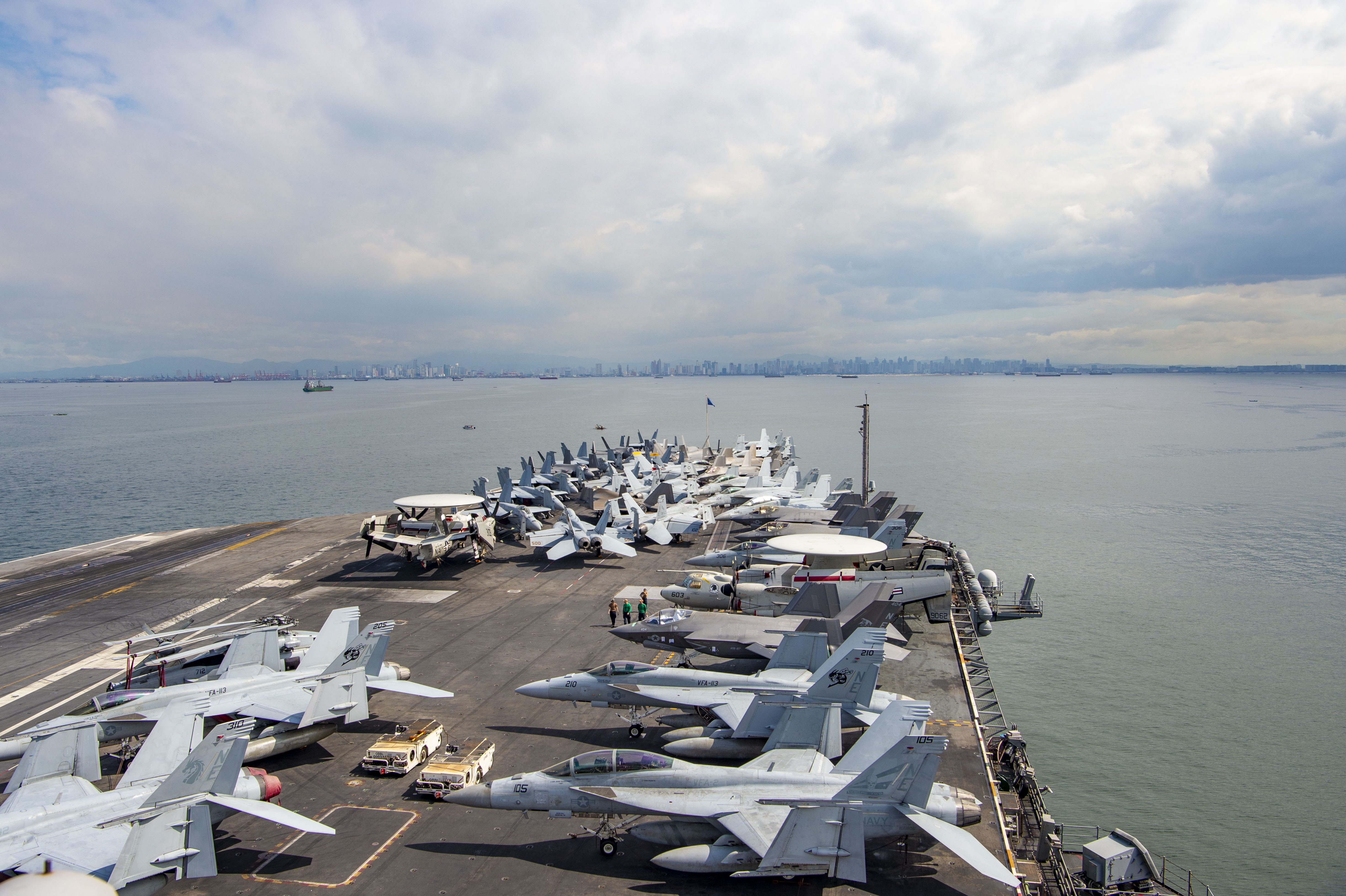
The Carl Vinson Carrier Strike Group and Philippine Navy concluded joint drills in the South China Sea on Thursday while being under observation by a People’s Liberation Army Navy (PLAN) frigate, which claimed, despite being in the despite being within the Philippine exclusive economic zone (EEZ), that it was conducting lawful activities in its own “territorial sea.”
Meanwhile, North Korea has resumed artillery firing drills in a previously demilitarized maritime buffer zone, prompting Seoul to respond with firing drills by Republic of Korea Marine Corps units and evacuating two islands near the North Korean firing zone.
The drills, known as Maritime Cooperative Activity (MCA), began on Wednesday and saw the CSG, consisting of carrier USS Carl Vinson (CVN-70) with embarked Carrier Air Wing (CVW) 2, cruiser USS Princeton (CG-59) and destroyers USS Kidd (DDG-100) and USS Sterett (DDG-104), carrying out joint activities and sailing with Philippine Navy offshore patrol vessels BRP Gregorio del Pilar (PS-15, ex-USCGC Hamilton WHEC-715) and BRP Ramon Alcaraz (PS-16, ex-USCGC Dallas WHEC-716) and landing platform dock BRP Davao del Sur (LD-602). A Philippine Navy AW109 helicopter also conducted a deck landing on Carl Vinson.
PLAN ships were in the vicinity observing the drills with a frigate already in the designated exercise area when the Philippine ships arrived there near dawn on Wednesday, according to the Philippines Daily Inquirer, which also reported that a PLAN destroyer also showed up following radio calls between Gregorio del Pilar and the PLAN frigate. During the calls, the Philippine Navy ship stated that the PLAN ship was sailing within the Philippine EEZ and asked what its intention were, and received the response, “Philippine warship 15, this is Chinese Navy warship 570 conducting lawful activities in our territorial seas, over,” according to the Inquirer report. The PLAN frigate reportedly did not respond to a subsequent radio call and, at 8 a.m., a PLAN destroyer with hull number 174 appeared in the exercise area as well. China claims much of the South China Sea as its territorial waters.
The hull numbers of the two PLAN ships corresponded to Luyang III-class destroyer CNS Hefei (174) and Jiangkai II class frigate CNS Huangshan (570). Both ships are part of the PLAN’s South Sea Fleet. In a social media post on Thursday, the Armed Forces of the Philippines released photos and videos of the MCA, which included two videos of Huangshan shadowing Philippine Navy ships on Wednesday.
The People’s Liberation Army (PLA) Southern Theater Command, under which the South Sea Fleet falls, issued a release on Wednesday night stating that naval and air forces were organized to conduct routine patrols in the South China Sea on Wednesday and Thursday. On Friday, the command issued a statement saying it organized a routine joint naval and air exercise in the South China Sea but provided no further details.
On Thursday, China Ministry of Foreign Affairs spokesperson Wang Wenbin criticized the U.S. –Philippine drill during his daily press conference. “We would like to stress that the US and the Philippines’ muscle-flexing, provocative military activities in the South China Sea are not conducive to managing the situation on the sea and handling maritime disputes. We urge relevant countries to stop the irresponsible moves, and respect regional countries’ effort to uphold peace and stability in the South China Sea,” said Wang.
The Carl Vinson CSG is now docked in Manila on a scheduled port visit, having arrived there on Friday, according to a Navy release.
Meanwhile, North Korea conducted a firing drill on Friday morning, firing close to 200 shells into the waters off its west coast. South Korea claimed the shells landed in the northern side of the sea border in the Yellow Sea but within a maritime buffer zone agreed to by the two Korea’s under the 2018 Comprehensive Military Agreement (CMA). That agreement, however, was scrapped by North Korea in November last year following Seoul’s decision to suspend a part of the agreement after North Korea’s Nov. 21 satellite launch.
The firing prompted South Korea to issue an emergency evacuation order for civilians on the South Korean western border islands of Yeonpyeong and Baengnyeong. At 3 p.m. that day, ROK Marine Corps units stationed on both islands carried out live firing into the nearby waters with their tanks and self-propelled artillery in response.
In an English-language statement carried by state media Korean Central News Agency (KCNA), the North Korean military claimed 13 companies and a platoon force of the southwestern coastal defense under the 4th Corps of the Korean People’s Army (KPA) staged a naval live-shell firing drill from 9 a.m. to 11 a.m on Friday. It was carried out with 47 artillery pieces firing a total of 192 shells. “The claim of the military gangsters of the Republic of Korea that the KPA fired naval artillery shells into the waters north of Paekryong Island and Yonphyong Island, a so-called buffer zone in the West Sea of Korea, is a far-fetched assertion to mislead the public opinion, and their evacuation and firing in return are also a trite method to throw the responsibility for the escalating tension on the KPA’s drill,” said the statement.
The South Korean military on Friday had issued a release stating that since Dec. 29 the ROK Army and U.S. Army conducted combined firing drills in Pocheon-si, Gyeonggi-do Province, which lies close to the border. The KPA warned that if its enemies commit an act that may be regarded as a provocation under the pretext of counteraction, the KPA will respond with tough counteraction on an unprecedented level.





